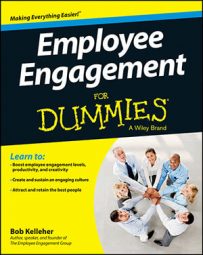You can't expect to make a credible business case for employee engagement if you don't include a set of business goals and objectives, can you?
If your leadership team wanted to increase sales, they would put in place sales objectives. If they wanted to decrease defects in manufacturing, they would outline quality objectives. If they wanted to reduce shrinkage in the retail chain, they would outline your objectives to minimize theft and returns. But something funny often happens with employee engagement.
Something happens in the firm — for example, employee turnover spikes — and someone cries, “Let's focus on employee engagement!” and off you go. No goal, and few objectives.
Employee engagement should be viewed as part of your overall strategic planning process. As such, it needs to be budgeted, tracked, and championed. Most important, it needs to follow a set of organizational objectives. Anything short of this, and you run the risk of turning employee engagement into a “flavor of the month”–type program.
Here are some engagement-related goals and objectives that would apply to most any firm:
Become an “employer of choice” in your industry. Employers of choice — think Apple, Google, Southwest Airlines, Procter and Gamble, Whirlpool, Timberland, 3M, Starbucks, and so on — receive more résumés than their competitors. It follows, then, that these companies enjoy the benefit of choosing from more qualified candidates.
Indeed, according to Dr. Wayne Cascio, author of Investing in People: Financial Impact of Human Resource Initiatives (FT Press) and a distinguished professor and instructor at the University of Colorado, firms that make Fortune magazine's annual “Top 100 Places to Work” list receive twice as many applications as firms that are not on the list.
It's a simple concept, really: If you receive twice as many résumés from qualified candidates for a position as your competitor, you'll be able to select higher-caliber talent. Engaging your workforce is the first step in becoming an employer of choice — and of gaining all the associated benefits.
Improve employee retention. Employee turnover is extremely expensive. Studies show that the cost to replace one person who resigns is, on average, equivalent to that person's annual salary, but can be much more depending on the person's role in the company.
Fortunately, you can improve employee retention through engagement. Improving employee engagement will also help you retain your top employees, which will boost your image as a high-performing organization, which will help you draw even more engaged employees.
Build a culture of high performance. Hopefully, you're beginning to see that an improvement in employee engagement leads to an increase in productivity and, over time, an increase in company performance (and profits)!
Improve customer satisfaction. As you'll see throughout this book, engaged employees lead to improved customer satisfaction. Customers will always be put off by employees who are disengaged; it follows, then, that customers will generally respond more positively to employees who are engaged.
Increase shareholder value (for companies with shareholders). Not to be all “broken record” about it, but the evidence is overwhelming. Companies with engaged employees outperform their peers. These companies enjoy increased revenue, reduced absenteeism, reduced shortages, improved safety, improved quality, stronger innovation, and reduced business costs. That translates to increased shareholder value!
Reduce absenteeism. You should track by department your employee absenteeism and set goals to improve your metrics. Chances are, those business units that have high absenteeism also have higher disengagement.
Other objectives you might want to consider depending on need include increasing revenue, improving safety and wellness, increasing the number of innovative ideas, increasing the number of new hires that join the firm through employee referrals, and of course, improving the overall employee engagement survey metrics.
The ultimate goal here is employee engagement, not employee satisfaction. But of course, if done well, employee engagement can lead to employee satisfaction.
It's not enough to simply say, “Employee engagement is of critical importance to this company. We're going to invest in it and measure it.” Even if you have the best intentions, this will sound to your staff like so much hot air because it's simply too broad.
Chances are, your employees have some idea of the specific challenges your organization faces in terms of engagement, and will appreciate your acknowledgement of the specific mileposts that will help resolve them.
By the time you make any announcement of this sort, you should have identified your goals and decided upon how they will be measured, tracked, and reported. If you want to reduce turnover to single digits, tell your staff not only that this is an objective, but also how your performance and progress will be tracked.
If your goal is to have 50 percent of new hires come from employee referrals, tell your staff what the benchmarks are both within your company and against competitors, if those are your metrics.
Sharing your plan in detail gives your message credibility. Employees can see the extent of thought and preparation that has been devoted to the specifics. This makes a much stronger impression than airy proclamations like, “Employees are our greatest asset.” When you then follow up on these messages, you supplement your credibility much more than if you had reported successes that were not explicitly tied to your goals.

